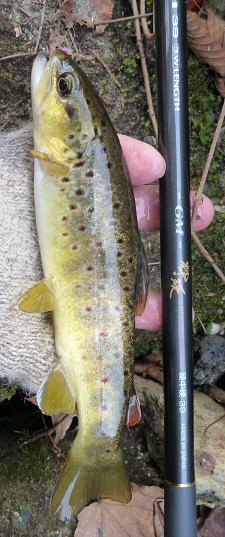Trip Report - 12-27-14
Saturday was a very interesting day. Klags and I were fishing a small stream in a Connecticut state forest. The stream was small enough and placid enough that stealth was critical. There were very few spots where a broken surface made it hard for the fish to see an approaching angler. I spent a lot of time on my knees.
Even though only one of the fish I caught was a result of sight fishing, the day was a lot more like hunting than fishing. There was a lot of stalking involved, with a different stalk required for each fish I caught.
The day was also the second time I had tried chochin-tsuri - "lantern fishing" - and the first time that I was able to catch fish with it. I won't be the last! It is a very precise way to fish, but also a very exciting one.
It is called lantern fishing because it is reminiscent of the way people used to carry lanterns in Japan. They would use a short cord to tie a lantern to the end of a bamboo pole. Held aloft, the lantern would light a larger area. In lantern fishing, anglers use a very short line relative to the length of the rod, perhaps only 5-6' with a 17' rod. Lantern fishing is done with either flies or bait.
All my fish Saturday were caught with a Suntech Suikei 39 and a pink Ultra Chenille worm. The first fish was caught on a worm tied with a single size 20 hook. Subsequent fish were caught on a worm tied with a pair of size 26 hooks.
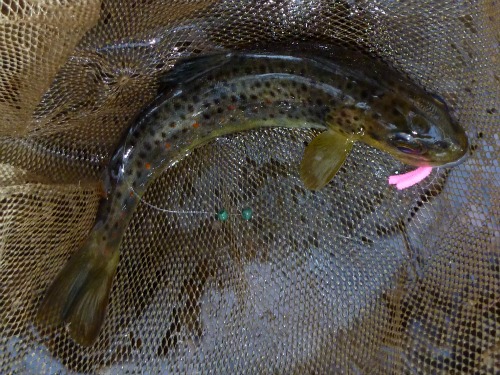
My first fish was caught midstream over a dark rocky bottom. By far, it had the darkest coloration. My other fish were caught over light colored sand and rock, and were much lighter. I started out with a keiryu rig - about 10' of 5X tippet, three Bright markers, a single #6 shot (to which I almost immediately added a second) and a foot of 6X tippet to the hook.
When the fish in the above photo took the worm, the markers shot about 8" to the side. There was no mistaking that take for a rock! No strike was necessary. I just raised the rod to tighten the line and the fish was solidly hooked.
Not long after that, though, I managed to get the line impossibly tangled and switched from a keiryu rig to a tenkara rig, with size 3.5 line in place of the original 5X, about 3' of 6X tippet and a single #6 shot to get the chenille worm to the bottom quickly.

The second fish came from a fairly deep pool, right off the bank in front of a downed tree. Klags had seen fish in that spot the last time he fished the stream. When he told me where they were holding, it seemed to be a situation similar to one I had faced in the Catskills last spring. I thought the best way to present a fly to the fish was to be fairly far back from the bank and drop a fly straight down to the fish, moving the rod so that the worm achieved a dead drift as close to shore as possible. Kneeling just to the left of the upended tree roots, far enough back from the edge that a fish couldn't see me, I couldn't see the water I'd be fishing. I rerigged so that I had about 2.5 - 3' of tenkara line and 2' of tippet, which allowed me to keep the rod just about horizontal.
Keeping the line vertical assured that the worm was drifting at the right speed. After four or five drifts, each a little closer to shore than the last, the rod tip jerked downwards. Fish on. I moved closer to the edge to try to keep the fish out of the debris at the left center of the photo but the fish was strong enough and the rod soft enough that he made it.
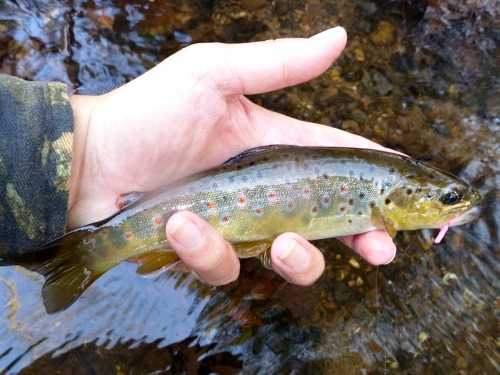
The line stopped and I was sure I was now hooked to a branch rather than to a fish. I managed to get down into the stream and start pulling branches out of the little log jam. Surprisingly, the fish was still hooked!
I had previously lost the first (single hooked) worm in a tree and was fishing with a worm like the one shown in the upper right hand photo, with two size 26 hooks. Both hooks were firmly embedded and that fish wasn't getting away!
That's the first time I've actually caught fish with the lantern fishing technique (extremely short line, fished essentially vertically rather than cast). I'd tried it once before with dry flies and although I got a lot of hits I wasn't able to hook any of them. If that sounds to you a bit like dapping, it does to me too. It's not tenkara, though, it's lantern fishing, so the "tenkara isn't dapping" refrain is still technically correct.
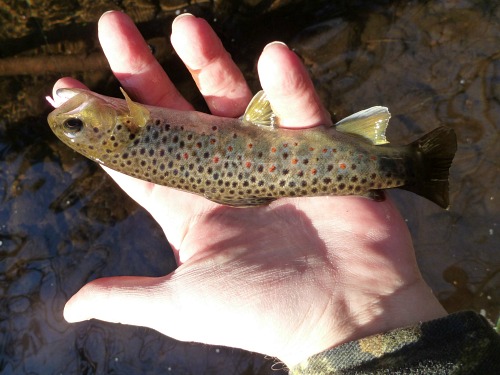
The third fish, shown above, was the only one I saw and specifically cast to. It was at the far side of a pool and much too far away to use the 5' line. I was again fishing on my knees, having crept close enough to almost reach the fish with the rod fully extended and a "normal" tenkara line length (line equal to the rod plus a meter of tippet). I misjudged the distance and my cast was too short, but he came over and picked up the worm as it drifted past. That time I struck, and struck too soon! On the next cast he picked it up again though! This time I waited to see the line twitch and hooked him easily.
Between this fish and the next one, I switched back and forth between a normal length tenkara line and a short lantern fishing line, depending on the lie I was trying to fish.

The last fish of the day was caught in the plunge pool above. That stick you can see curving upwards to the left effectively protected the head of the pool. Several casts to the open water to the left of the stick yielded nothing. I switched back from the tenkara line to the lantern fishing line and crept forward far enough that I could get the rod tip on the other side of the stick. At that point, a little side cast put the worm right into the white water at the head of the plunge pool. I let the worm drift into the middle of the pool and then cast again into the white water. As before, on the fourth or fifth cast, as the line approached the middle of the pool the rod tip jerked to the right. I didn't have to set the hook, the fish did it himself.
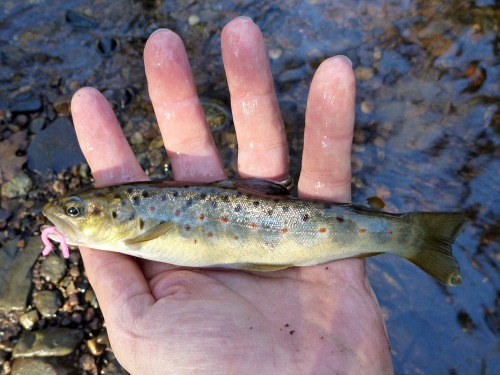
With a line that short in relation to the rod, you can't really lift the rod. The fish is tearing around the pool and the rod tip is dancing a jig and you have to just start collapsing the rod. That might be risky if the fish was large, but for a 7 incher it was no problem and did not put too much stress on the rod. I guess that's why lantern fishing rods in Japan tend to be stiff - they just lift the fish out of the water and then collapse the rod. Having the fish run around the pool is more exciting but probably eliminates the chance for a second fish from the pool.
Anglers who favor dry flies talk about the excitement of seeing a fish take your fly on the surface. I have to tell you, that is nothing compared seeing your rod tip jerk a foot to the side and a fish start tailwalking around the pool. That will raise your pulse immediately!
I would definitely recommend trying lantern fishing next time you are presented with a technical fishing situation where a regular cast just isn't possible but where you can creep close enough to fish almost directly under your rod tip. The longer your rod, the less stealthy you have to be.
I've only tried lantern fishing twice, and I got several hits both times. I was only able to hook the fish the second time, though, and I think there may be a couple reasons for that.
The first time, when I was fishing dries, I kept ALL of the tippet off the water. The line was straight down from rod tip to fly, so there was absolutely no slack. When a fish hit the fly, it immediately felt the tension on the line. I hadn't really thought about that until I first read about "zero tension" keiryu fishing. The theory behind it is that the fish will spit out the bait if it feels tension on the line. I have experienced that for myself and I know that fish will spit out a baited hook if they feel tension. If they'll spit out bait, and they will, you know they'll spit out an artificial fly.
A second possible reason for fish spitting out a baited hook is that they feel the hook. Worms are soft. Hooks aren't. Feeling the hook isn't something I thought about much until I recently started fishing the pink chenille worms with size 26-32 hooks. When I tied them with size 12 hooks, fish were quick to spit them out.
I remember one time years ago seeing four different fish hit a pink chenille worm and spit it out before I could react. That was not only all on just one cast, it was in one small pool within the space of 2-3 seconds. The line didn't so much as quiver. They were just incredibly fast.
When fishing the worms with very small hooks, the fish seem to hold on to them longer. The first time I tried the chenille worm with a #32 hook in a deep, slow pool, the line just stopped but it was often the bottom so I slowly lifted the rod to see if the drift resumed or if I got a head shake in return. I missed some fish, but several held onto the worm for a couple seconds before I was sure they were fish rather than weeds. On Saturday, three of the four fish I caught hit the worm and then swam away with it. The line didn't just twitch, it jerked to the side.
Either the fish didn't feel immediate tension or the hooks were small enough that the fish didn't notice them immediately. Or, it may be that the small hooks are just extremely effective at hooking fish and once the fish took the worm they couldn't spit it out because the hook caught.
I'm not sure which is (are?) correct, but I am very impressed with the size 26 hooks on the pink chenille worm. I'm also very impressed with the pair of hooks as opposed to a single hook. On Saturday, I caught two fish on the front hook, one on the back hook and one that was hooked with both. I went to two hooks to try to reduce the chance that a fish hitting the worm bit a part of the worm that didn't have a hook. It seems to have worked.
Had I tied the worm with three hooks, it would have been the artificial equivalent of Stewart tackle. In his 1857 book The Practical Angler, WC Stewart broke new ground on several topics. Most notably, it was the first book to recommend fly fishing upstream rather than downstream, which up until then was the norm. The book also introduced the Black Spider to the world. It became known as the Stewart Spider even though he clearly indicated that it had been shown to him by James Baillie. Third, even though he is best known for fly fishing, he also wrote about worm fishing, as did many of the early fly fishing authors. In The Practical Angler he introduced what later became known as Stewart tackle, with three or even four small hooks holding the worm rather than one larger hook. He had determined that it was significantly more effective. I think he was right.
TenkaraBum Home > Trip Reports > Trip Report 12-27-14
“The bitterness of poor quality remains long after the sweetness of low price is forgotten” - Benjamin Franklin
"Be sure in casting, that your fly fall first into the water, for if the line fall first, it scares or frightens the fish..." -
Col. Robert Venables 1662
As age slows my pace, I will become more like the heron.
Warning:
The hooks are sharp.
The coffee's hot.
The fish are slippery when wet.
Beware of the Dogma
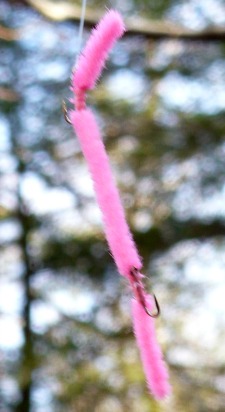
Pink Ultra Chenille Worm



